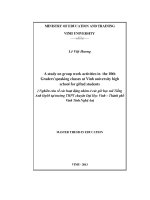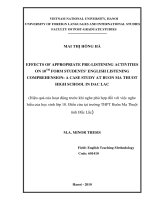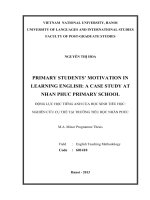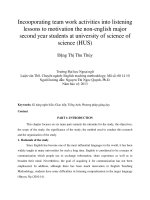nglish as a foreign language (efl) students` attitudenes towards pair work activities in speaking lessons a case study at a college in can tho city (tt)
Bạn đang xem bản rút gọn của tài liệu. Xem và tải ngay bản đầy đủ của tài liệu tại đây (1.61 MB, 16 trang )
ABSTRACT
Although several studies have been undertaken into how pair work influences
students’ learning speaking English as a foreign language, little research on this area of
interest exists within the context of teaching and learning English in Can Tho, Mekong
Delta, Vietnam. This research was therefore conducted to investigate students’ attitudes
towards pair work activities in speaking lessons at a college of tourism in Can Tho City.
Participants in this study were one-hundred twenty-six ESP students. Quantitative and
qualitative data were collected from questionnaires, semi-structured interviews, and
classroom observations. The findings of this study reveal that pair work activities in
speaking lessons brought students interest and confidence. Pedagogical implications and
recommendations for the further research are also provided.
iii
TABLE OF CONTENTS
Declaration ............................................................................................................................ i
Acknowledgements .............................................................................................................. ii
Abstract ............................................................................................................................... iii
Table of contents ................................................................................................................. iv
List of abbreviations ........................................................................................................... vii
List of tables ...................................................................................................................... viii
CHAPTER ONE: INTRODUCTION .............................................................................. 1
1.1 Rationale ........................................................................................................................ 1
1.2 Research aim and question ............................................................................................. 3
1.3 Research hypothesis ....................................................................................................... 3
1.4 Significance of the study ................................................................................................ 3
1.5 Organization of the study ............................................................................................... 3
CHAPTER TWO: LITERATURE REVIEW ................................................................. 5
2.1 Attitudes ......................................................................................................................... 5
2.2 Pair work ........................................................................................................................ 5
2.2.1 Definitions ............................................................................................................... 5
2.2.2 Advantages of pair work ................................................................................................. 6
2.3 Speaking ......................................................................................................................... 7
2.3.1 Definitions ............................................................................................................... 7
2.3.2 The importance of speaking skill ............................................................................ 8
2.3.3 Some factors affecting students’ speaking skill....................................................... 8
2.3.4 Speaking components.................................................................................................... 10
2.4 Related studies ............................................................................................................. 11
CHAPTER THREE: RESEARCH METHODOLOGY .............................................. 14
3.1 Research design ............................................................................................................ 14
3.2 Participants ................................................................................................................... 15
3.3 Research instruments ................................................................................................... 17
3.3.1 Questionnaires ....................................................................................................... 17
iv
3.3.2 Semi-structured interviews .................................................................................... 19
3.3.3 Classroom observations ................................................................................................ 20
3.4 Materials ....................................................................................................................... 21
3.5 Data collection procedures ........................................................................................... 21
3.5.1 Administering questionnaires ............................................................................... 22
3.5.2 Administering semi-structured interviews ............................................................ 22
3.6 Data analysis procedure ............................................................................................... 24
CHAPTER FOUR: FINDINGS ...................................................................................... 25
4.1 Findings from the questionnaires ................................................................................. 25
4.1.1 Students’ interest towards pair work activities in speaking lessons ...................... 26
4.1.2 Students’ pressure towards pair work activities in speaking lessons .................... 27
4.1.3 Students’ confidence towards pair work activities in speaking lessons ................ 28
4.1.4 Students’ attitudes towards classroom management in speaking lessons ............. 30
4.1.5 Students’ attitudes towards assessment in speaking lessons .................................... 31
4.2 Findings from classroom observations ........................................................................ 32
4.2.1 Teaching strategies ................................................................................................ 32
4.2.2 Teaching resources ................................................................................................ 33
4.2.3 The roles of the teacher ......................................................................................... 34
4.2.4 Interaction .............................................................................................................. 35
4.2.5 Mistake correction ................................................................................................. 36
4.2.6 Students’ participation ................................................................................................... 36
4.3 Finding from the interviews ......................................................................................... 37
4.3.1 Students’ positive attitudes towards pair work activities in speaking lessons ...... 37
4.3.2 Benefits from pair work activities ......................................................................... 39
4.3.3 Challenges from pair work activities .......................................................................... 40
CHAPTER FIVE: DISCUSSION AND CONCLUSIONS ........................................... 41
5.1 Summary of key findings ............................................................................................. 41
5.2 Discussion .................................................................................................................... 42
5.3 Conclusions .................................................................................................................. 43
5.4 Pedagogical implications and recommendations ......................................................... 43
v
5.5 Limitations ................................................................................................................... 44
5.6 Recommendations for further research ........................................................................ 44
REFERENCES ................................................................................................................. 45
APPENDICES
Appendix 1: Questionnaire for students ............................................................................... 1
Appendix 2: Observation sheet ........................................................................................... 4
Appendix 3: Interview questions ........................................................................................ 6
Appendix 4: Raw calculation .............................................................................................. 7
Appendix 5: Transcription of the individual interview ........................................................ 9
vi
LIST OF ABBREVIATIONS
EAP
English for Academic Purposes
EFL
English as a Foreign Language
ESP
English for Specific Purposes
LREs
Lexical Language-Related Episodes
MoET
Ministry of Education and Training
OB
Observation
S1
Semester One
vii
LIST OF TABLES
Page
Table 3.1: Participants’ backgrounds .............................................................................. 15
Table 3.2: The curriculum ............................................................................................... 16
Table 3.3: Summarized items for each cluster in the questionnaire ................................ 17
Table 3.4: Reliability statistic .......................................................................................... 18
Table 3.5: Research procedure ........................................................................................ 21
Table 3.6: The interviewees’ conditions .......................................................................... 23
Table 4.1: Descriptive statistics (cluster of interests) ..................................................... 26
Table 4.2: One Sample t-Test (like speaking) ................................................................. 26
Table 4.3: Descriptive Statistics (cluster of pressure) ..................................................... 27
Table 4.4: One Sample t-Test (limited time in speaking)................................................ 28
Table 4.5: Descriptive statistics (cluster of confidence) ................................................. 28
Table 4.6: One Sample t-Test (opportunities to speak) ................................................... 29
Table 4.7: Descriptive statistics (cluster of classroom management) ............................. 29
Table 4.8: One Sample t-Test (management is not easy) ................................................ 30
Table 4.9: Descriptive statistics (cluster of classroom assessment) ................................ 30
Table 4.10: One Sample t-Test (assessment is easy) ....................................................... 31
viii
CHAPTER ONE
INTRODUCTION
This chapter presents the rationale, research aim, question and hypothesis. It
concludes with significance of the study and thesis organization.
1.1 RATIONALE
English is now widely accepted as an international language of several aspects of life
including communication (e.g., Crystal, 2003; De Swaan, 2001; Le & Nguyen, 2017;
Nguyen & Nguyen, 2018). This global trend of English language use has been advocated
by the Vietnamese government in ways that English is viewed to be the most important
foreign language in Vietnam across all levels of Vietnamese educational system (Le &
Nguyen, 2017). In particular, students start learning English at Grade three. However,
most of the students lack the ability of English language use to meet their current
academic needs, future careers and other purposes. Therefore, the Ministry of Education
and Training (MoET) launched the National Foreign Languages 2020 Project to promote
the quality of teaching and learning how to use foreign languages including English for
communicative competence. By 2020, this government policy requires graduates to use
English independently and confidently in communication, academic study and work in
Vietnam and in foreign enterprises. However, the majority of graduates could not speak
English at a required pre-intermediate level (MoET, 2008).
Established in 2006, College of Tourism in Can Tho City has been committed to
training and providing tourism staff with knowledge of this area to serve local needs and
those in the Mekong delta. Students in this college came from different backgrounds from
different provinces of this community. Their ages range from 18 to 24. These students
were high school students and employees. In other words, their own knowledge, skills,
cognitive abilities, curiosity, experience and attitude towards English were also
completely different. However, they had some similarities. They wanted to be able to
1
speak English fluently. In their general English classes, they had few chances to speak or
use English. They could only answer their teacher’s questions when they were asked.
After leaving their classes, they could not speak English to express what they wanted to,
even simple things around them.
The curriculum currently used in ESP classes, consisting of 240 periods, was
assigned by the school principal. In a typical speaking class, the teacher was the center
while the students were passive. They only listened to and answered the teacher’s
questions. The students usually combined answers given by the teacher to make a speech
for their presentation. As a result, only few students could give their presentation in front
of the class, whereas others could copy and learnt by heart for their final oral
examinations. Consequently, the students did not have the ability to communicate on their
own. In addition, the students’ speaking skill much depended on writing. In class,
whenever they were asked to speak, they often spent a lot of time preparing their speaking
by writing a complete composition. When they were required to make a presentation in
front of the class, all what they could do was to read what they had written on the paper.
Three challenges encountered by students in speaking classes include inhibition,
lack of vocabulary and time budget spent in speaking. Students were inhibited whenever
they wanted to say or expressed their opinions or ideas in English to their partners or in
the classroom. This resulted from the fact that they were afraid of making mistakes,
fearful of criticism or losing face. They were even too shy in front of the attention by
others while speaking (Nguyen & Tran, 2015).
Regarding lack of vocabulary, students found it hard to express ideas as a result of
learning with traditional methods like teacher-centered or grammar translation. The
teachers just read or lectured while students were very passive. Taken together, students
were not given opportunities to communicate with other classmates.
With regard to time spent in speaking, students in the large class of forty on
average had very little opportunity to talk. Also, in a mixed ability class, some dominating
students said a lot while others spoke less or not at all.
These issues mentioned above initiate this current study.
2
1.2 RESEARCH AIM AND QUESTION
The aim of the study is to investigate students’ attitudes towards pair work activities in
speaking lessons at a college of tourism in Can Tho City. The study is guided by the
research question: What are students’ attitudes towards pair work activities in speaking
lessons?
1.3 RESEARCH HYPOTHESIS
It is hypothesized that EFL students could become more confident, learn more from their
partners, and have more opportunities to use English through pair work activities in
speaking lessons.
1.4 SIGNIFICANCE OF THE STUDY
Although several studies have been conducted on the effects of using pair work in
speaking classes, little research has been undertaken about how pair work strategies could
improve EFL students’ English competence within the teaching and learning context in
Vietnam. Therefore, the findings of this study are expected to contribute to the
improvements of teaching of English, particularly how to use pair work to enhance
students learning speaking classes at a college of tourism in Can Tho City. In particular,
this study offers teachers insights into how to design a variety of pair work activities and
strategies that involve students in communicative tasks.
1.5 ORGANIZATION OF THE STUDY
This thesis is organized into five chapters: (1) Introduction, (2) Literature review, (3)
Methodology, (4) Findings, (5) Discussion and Conclusions.
Chapter One introduces the rationale for the study, research aim, question and
hypothesis. The significance and the organization of the study are also presented.
Chapter Two reviews the literature relevant to the thesis topic in order to establish
the foundation for the present study.
Chapter Three presents the research methodology. It includes research design,
participants, context of the study, instruments, and data collection procedure.
3
Chapter Four reports the findings of the study to answer the research question
through questionnaire, observations and semi-structured interviews.
Chapter Five discusses the findings of the study. The chapter concludes with the
implications, limitations of the study and recommendations for further research.
4
CHAPTER TWO
LITERATURE REVIEW
This chapter reviews the literature relevant to this study. It includes the definitions
of key terms such as attitudes, pair work, speaking and its components and factors
influencing students’ speaking skill. The chapter concludes with related studies.
2.1 ATTITUDES
There are several definitions of attitudes in the literature. Ajzen (2005) defines attitude as
disposition to respond to an object, person, institution or event in a favorable or
unfavorable way. This construct implies measurable responses which reflect or influence
individuals’ thought or action towards a person, thing, place or event (Ajzen, 2005).
Hashemi (2005) defines attitudes as someone’s opinions or views towards a particular
subject matter. Thus, attitudes could influence how individuals approach many aspects in
life. It is, therefore, believed that individuals with positive attitudes usually progress more
rapidly in foreign language learning. Attitudes are closely related to our beliefs and are
based upon experiences, thus, it is believed that effective language teaching strategies can
encourage students to be more positive towards the learning process in general and
learning speaking in particular (Ibnian, 2012). Shahrzad (2016) defines attitude as opinion
and feeling that everyone has about something. Learning a foreign language is no
exception. Thus, attitude to language is a construct that interprets an individual’s
linguistic behavior.
For the purposes of this study, attitudes are viewed as responses and reactions that
students have towards learning English as a foreign language.
2.2 PAIR WORK
2.2.1 Definitions
Pair work is defined as a strategy that involves students in exposing themselves to
opportunities to communicate ideas with others (e.g., Ellis, 2003; Gass & Mackey, 2006,
5
investigating factors that influence teachers’ attitudes towards pair work activities in
speaking lessons at different colleges of sciences in Can Tho City may provide multiple
views of this type of learning strategy to make best use of student learning outcomes in
speaking. Further research with a larger sample size can result in more holistic views by
teachers and students across the school in particular and other teaching contexts in the
community in general.
REFERENCES
1. Abbaspour, F. (2016). Speaking competence and its components: A review of
literature. International Journal of Research in Linguistics, Language Teaching and
Testing, 1(4), 144-152.
2. Ajzen, I. (2005). Attitude, personality and behavior (2nd Ed.). New York: Open
University Press.
3. Bashir, M., Azeem, M., & Dogar, A. H. (2011). Factor effecting students’ English
speaking skills. British Journal of Arts and Social Sciences, 2(1), 38-40.
45
4. Boyatzis, R. E. (1998). Transforming qualitative information: Thematic analysis and
code development. Thousand Oaks, California: SAGE Publications, Inc.
5. Brown, H. D. (2004). Language assessment principles and classroom practices. New
York: Pearson Education, Inc.
6. Brown, H. D. (2007). Principle of language learning and teaching. White Plains, NY:
Pearson Longman.
7. Cameron, L. (2001). Teaching languages to young learners. Cambridge: Cambridge
University Press.
8. Cohen, L., & Manion, L., & Morrison, K. (2007). Research methods in education (6th
Ed.). Routledge.
9. Cordeiro, M. C. (2017). Pair work for developing speaking skills. FCSH
Universidade Nova De Lisboa.
10. Creswell, J. W. (2014). Qualitative, quantitative and mixed methods approaches.
SAGE Publications, Inc.
11. Crystal, D. (2003). English as a global language (2nd Ed.). Cambridge: Cambridge
University Press.
12. Derakhshan, A., Beheshti, F., & Khalili, A. N. (2016). Developing EFL learner’s
speaking ability, accuracy and fluency. Canadian Center of Science and Education,
6(2), 1925-4776.
13. De Swaan, A. (2001). Words of the world. Cambridge: Polity Press.
14. Dornyei, Z. (2003). Questionnaires in second language research. Lawrence Erlbaum
Associates, Inc.
15. Ellis, R. (2003). Task-based language learning and teaching. Oxford: Oxford
University Press.
16. Ellis, R. (2009). The differential effects of three types of task planning on the fluency,
complexity, and accuracy in L2 oral production. Applied Linguistics, 30(4), 474–509.
doi:10.1093/ applin/amp042.
17. Fraenkel, J. R., Wallen, N. E., & Hyun, H. H. (2012). How to design and evaluate
research in education. SAGE Publications, Inc.
46
18. Gass, S. & Mackey, A. (2006). Input, interaction and output in second language
acquisition. In B. Van Patten & J. Williams (Eds.), Theories in second language
acquisition (pp. 175-199). Mahwah, NJ: Lawrence Erlbaum.
19. Gay, L. R., Mills, G. E., & Airasian, P. W. (2009). Educational research:
Competencies for analysis and applications (9th Ed.). Upper Saddle River, New
Jersey: Prentice Hall.
20. Harmer, J. (2001). The practice of English language teaching (3rd Ed.). Longman.
21. Hashemi, H. (2005). The effectiveness of a proposed program for teaching Arab
language in achievement and attitudes of non-native speakers in Oman. Unpublished
Ph.D. Dissertation, Cairo University, Egypt.
22. Ibnian, S. S. K. (2012). Group work and attitudes of non-English major students
towards leaning EFL. The World Islamic Sciences and Education University
(W.I.S.E.), 2(4), 192-197.
23. Itkonen, T. (2010). Spoken language proficiency assessment. Master’s thesis,
University of Helsinky, Poland.
24. Kvale, S. (1996). Interviews: An introduction to qualitative research interviewing.
London: SAGE.
25. Lasito & Storch, N. (2013). Comparing pair and small group interactions on oral
tasks. SAGE, 44(3), 361-375.
26. Le, D. T. N., & Nguyen, H. B. (2017). Factors influencing group work of students in
learning English as a foreign language (EFL): A case study at a Vietnamese
university. Can Tho University. Journal of Science, 6, 9-16.
27. Le, D. N. T. (2017). Measurement of factors affecting English speaking skills of
students at the foreign languages department of Van Lang University. Research and
Science Today, 1(13), 138-147.
28. Lennon, P. (2000). The lexical element in spoken second language fluency. The
University of Michigan Press.
29. Linse, C. & Nunan, D. (2005). Practical English Language Teaching: PELT Young
Learners. New York: McGraw-Hill.
47
30. Maria, T. S., & Nadia, A. (2005). Questionnaire design. UNESCO international
institute for educational planning.
31. McDonough, K. (2004). Learner-leaner interaction during pair and small group
activities in a Thai EFL context. ELSEVIER, 32(2), 207-224.
32. Mitchell, H. Q. (2009). Traveler elementary and pre-intermediate. MM publications.
33. Moon, J. (2000). Children learning English. Oxford: Macmillan Heinemann
Publishers.
34. Nguyen, H. B. (2014). Teacher change in science education in a Vietnamese
university. PhD Thesis, Massey University, New Zealand.
35. Nguyen, H. T. (2012). The use of role-play activities to improve speaking skills for
the first-year English major students at Hanoi University of industry. Master’s thesis,
Hanoi Vietnam National University.
36. Nguyen, T. H., & Tran, M. N. (2015). Factors affecting students’ speaking
performance at Le Thanh Hien high school. Asian Journal of Education Research,
3(2), 8-23.
37. Nguyen, T. Q. (2013). The impact of context on a Vietnamese tertiary level English
teacher’s implementation of pair work. International Journal of Innovation in English
Language Teaching and Research, 2(1), 27-46.
38. Nguyen, T. T. B., & Nguyen, H. B. (2018). The effects of question-answer
relationship strategy on EFL high school students’ reading comprehension. European
Journal of English Language Teaching, 3(4), 34-48.
39. Nunan, D. (1999). Second language teaching and learning. Boston: Heinle and
Heinle Publishers.
40. Oxford, R. L., & Burry-Stock, J. A. (1995). Assessing the use of language learning
strategies worldwide with the ESL/EFL version of strategy inventory for language
learning SILL. ELSEVIER, 23(1), 1-23.
41. Ohta, A.S. (2001). Second language processes in the classroom learning Japanese.
Mahwah, NJ: Lawrence Erlbaum.
42. Oktaviani, N. (2013). Improving the students’ speaking skills through Think Pair and
Share technique of cooperative learning of grade XI IPA students of SMA Islam 1
48
Gamping in the academic year of 2013/2014. Master’s thesis, University of
Yogyakarta, Indonesia.
43. Rahimy, R., & Safarpour, S. (2012). The effect of using role-play on Iranian EFL
learners’ speaking ability. Islamic Azad University, Iran, 1(3), 50-59.
44. Richards, J. C., & Schmidt, R. W. (2002). Longman dictionary of language teaching
and applied linguistics. Longman Publishing Group.
45. Shahrzad, E, (2016). EFL students’ attitudes towards learning English language: The
case study of Kashan University students. Cogent Education.
46. Shteiwi, A. A., & Hamuda, M. A. (2016). Oral communication problems
encountering English major students: Causes & remedies. International Journal of
Social Science and Humanities Research, 4(2), 19-26.
47. Thornbury, S. (2005). How to teach speaking. Essex: Pearson Longman.
48. Tran, T. T. T. (2017). An investigation into students’ motivation in learning speaking
English with the native speaker at a college in the Mekong delta. Master’s thesis, Can
Tho University, Vietnam.
49. Zohairy, S. (2014). Effective pair work strategies to enhance Saudi pre-intermediate
college students’ language production in speaking activities. European Scientific
Journal, 10(2), 1857-7881.
INTERNET
50. Ministry of Education and Training (2008). Teaching and learning foreign
languages in the national educational system from 2008 to 2020. Hanoi, Vietnam:
Retrieved from: date March 20, 2018.
49









